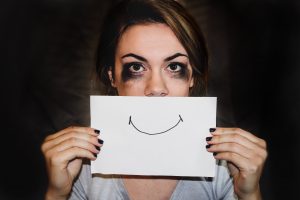Beyond Fear
Fearlessness is a place not absent of fear but beyond it.
When my two sons were just babies, I would sometimes awake at three in the morning overcome with fear. It was a sense of foreboding that tightly grabbed a hold of me, leaving me desperate, breathing in those short, panicky breaths unique to that hour. My mother used to say to never think about heady things in the dark of night. Nonetheless, I used those moments to pray that I’d live long enough to bring up my children to an age where they could care for themselves.
Perhaps such instances indicate that the root of fear lies in our profound attachments, caring very strongly about someone or something or some ideal. Underlying our most meaningful relationships is the stark awareness of mortality standing doggedly in the way of the blissful continuation of these connections. Fear is a real and visceral emotion, experienced physiologically in the body as well as psychologically in the mind. It has deeply-seated existential implications. Fear can shake us to the core.
 Truth be told, we are conditioned to feel fear, and therefore it becomes much like any bad habit. In given situations, we unwittingly choose fear, due to unconscious desires for things to be different than they are. The landmark 1920 experiment of Little Albert and the white rat, conducted by famed psychologist John B. Watson, will forever exemplify the capacity of the human being to become conditioned to pretty much anything. When Little Albert was 9 months old, Watson would watch him happily play = with a small white rat, presented to the boy as part of a conditioning experiment. Watson then paired loud, crashing noises with bringing the white rat into the room, and soon enough, Little Albert learned to fear his former furry friend. Albert would cry out in anguish every time he saw the white rat, even when it was accompanied by no noise at all. In the same way, we learn to generate fear reactions over and over again to many things in our lives.
Truth be told, we are conditioned to feel fear, and therefore it becomes much like any bad habit. In given situations, we unwittingly choose fear, due to unconscious desires for things to be different than they are. The landmark 1920 experiment of Little Albert and the white rat, conducted by famed psychologist John B. Watson, will forever exemplify the capacity of the human being to become conditioned to pretty much anything. When Little Albert was 9 months old, Watson would watch him happily play = with a small white rat, presented to the boy as part of a conditioning experiment. Watson then paired loud, crashing noises with bringing the white rat into the room, and soon enough, Little Albert learned to fear his former furry friend. Albert would cry out in anguish every time he saw the white rat, even when it was accompanied by no noise at all. In the same way, we learn to generate fear reactions over and over again to many things in our lives.
Every day, newspapers are filled with fear-provoking headlines. The New York Times recently lamented “Trading Partners Fear U.S. Consumers Won’t Continue Free-Spending Ways” and “News Analysis: A Fear That the Cure Could Be Poison.” Then there is Greed & Fear, the aptly named financial newsletter. Millions of us tuned in weekly to watch NBC’s Fear Factor. And this year highly successful, Oscar-nominated movies, like No Country for Old Men and There Will be Blood, are, at their core, horror films. Face it, fear sells. In 2003, we were fearful of Iraqi weapons of mass destruction reaching our shores; today, terrorism threat levels are part of a new post-9/11 norm, and some days, more than we’d like to admit, we are frightened by nothing more than the cast of our own shadows. These are scary times.
In the face of bad economies, terrorism threats and our own existential angst, what’s a person to do? Eastern scholar Chogyam Trungpa writes eloquently about fear and how to overcome it in his discussion of fearlessness, a place not absent of fear, but somewhere beyond it. “You might think that when you experience fearlessness, you will hear the opening to Beethoven’s Fifth Symphony or see a great explosion in thesky,” Trungpa says, “but it doesn’t happen that way…discovering fearlessness comes from working with the softness of the human heart.”
Cultivating the personal courage necessary for such an approach gives rise to what could be called a sense of daring, feeling excitement at the simple act of tending to one’s own unique path. Life becomes a creative process, incorporating fear rather than rejecting it, becoming curious about pain instead of ignoring it, embracing one’s demons, thus making them friends. Daring, one comes to see, has its own energy, uplifting and free. Fear, on the other hand, is experienced as discomfort in the body.
It is processed in the brain and interpreted in ways that all too often stimulate the primitive fight-or-flight response, sending reams of the stress hormone, cortisol, racing through the nervous system. Body and mind go into hyper-drive: eyes dilate, respiration increases, blood rushes to the extremities, readying for something as threatening as an advancing lion’s ferocious assault. But, these days, stress is more likely the result of family, work, or personal concerns and upsets, rather than the imminent threat of death-by-lion. Yet, the human body does not make this distinction. The resulting over-production of cortisol contributes to such stress related diseases as hypertension, cardiovascular disease, anxiety, depression, mood disorders and suppressed immune function. Fear literally makes us sick.
If fearfulness is a learned behavior, like Little Albert’s fear of the benign rat, and new patterns of learning can be chosen, why not choose fearlessness instead? The solution to overcoming fear lies not in finding the short-cut around it but in seeing fear’s fundamental paradox: Western culture views tenderness as weakness and repression of feelings as strength, but actually the opposite is true. Courage is born in the willingness to feel all of our human emotions, including the tenderness of a broken heart.
“The ideal of warriorship is that the warrior should be sad and tender, and because of that the warrior can be very brave as well,” Trungpa explains. “Without that heartfelt sadness, bravery is brittle, like a china cup. If you drop it, it will break or chip. But the bravery of the warrior is like a lacquer cup…if the cup drops, it will bounce rather than break. It is soft and hard at the same time.” Fearlessness is flexible.
A little known fact is that too much emphasis on “hope” in our lives only heightens the fear factor. We think to ourselves, “At least I can hope.” But by emotionally investing in certain outcomes, we place a heavy burden, like giant boulders, in our backpack. Carrying around all that extra poundage grows exhausting, our happiness balanced precariously on this result or that. Trumped-up hopefulness, unfortunately, is awash with attachment, disappointment just waiting to happen. Both hope and fear can become habit-forming, two sides of a repetitive volley. But rather than following the bouncing ball as it alternates between these two extremes, salvation is found in learning to stop resisting reality and simply accept what is true in the moment. Instead of closing down in the face of fear, the secret lies in choosing what may feel counterintuitive: opening up.
By exposing more of our tender heart to the world, revealing our true self to others, and doing that which we love the most, we are led by an intrinsic kind of bravery and capacity for daring. Open-heartedness, as the antidote to fear, goes a long way toward inspiring the boldness necessary to realize our most precious dreams and helps us through the particularly dark nights of the soul.
This first appeared in Ambassador Magazine, Detroit, Michigan
Tags: anxiety, fear, self development, terror








Leave a Reply